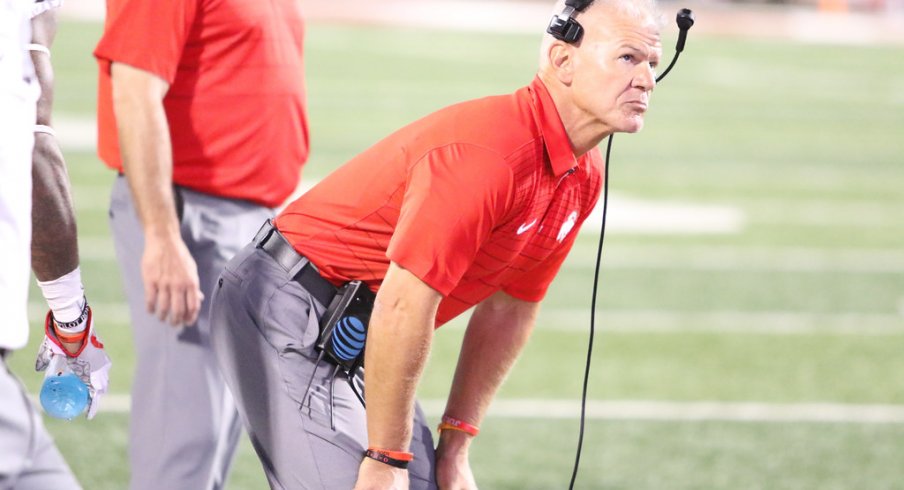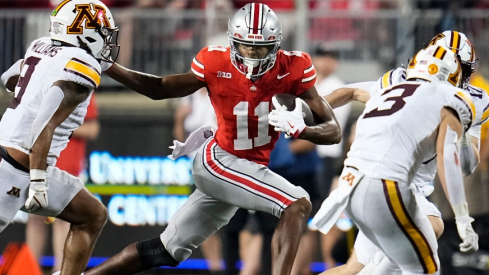Given the season's disappointing ending and the subsequent departures of stars Chase Young and Jeff Okudah along with co-coordinator Jeff Hafley, it's to forget just how dominant Ohio State's defense was last fall. The 2019 Buckeyes led the nation in total defense, allowing fewer yards-per-game than any OSU squad time since Jim Tressel's 2007 vintage snuck its way into the BCS title game.
Understandably, anxieties ran high as Hafley left for Boston College, as the architect of a redesigned system was gone after less than a year on campus. While his replacement, Kerry Coombs, helped allay some of those fears thanks to his recruiting prowess, unmatched enthusiasm, and track record of producing first-round talents in the secondary, questions remained about his impact on the scheme.
In his first public appearance since returning to the staff, he made it clear that he has no intention of changing what worked so well.
“I watched the whole season and how well they played, how hard they played. There’s no reason for us to make massive changes to what they’re doing defensively,” Coombs said during his introductory press conference last Wednesday. “Greg, Larry, Al, Matt, those guys have done a phenomenal job. So for me, right now, I’m in the meeting room with them in the afternoons, learning what they did. Trying to make sure that I’m adapting their terminology and the playbook. Going to make additions to it, going to make some alterations to it but at the same time, those guys are phenomenal coaches.”
As has been documented, that playbook centers almost exclusively around playing a 4-3 defense with only one safety in the middle of the field. The system's roots can be traced almost directly to Pete Carroll and a line of his former assistants who brought it to a handful of other destinations like San Francisco, where Hafley learned it as a 49ers assistant.
Though Coombs has never taught this specific system in nearly three-and-a-half decades of coaching, he is adamant that it will remain the foundational scheme in his first year as a college coordinator.
“There will be some coverage additions to what we do. But our base is going to be single-high defense," Coombs said. "That's what we're going to play.”
Of course, three-deep zone coverage isn't exactly unique. Coombs has had more than a little exposure to versions of the same system throughout his career, including the past two seasons while coaching the Tennesee Titans' secondary.
“THERE WILL BE SOME COVERAGE ADDITIONS TO WHAT WE DO. BUT OUR BASE IS GOING TO BE SINGLE-HIGH DEFENSE. THAT'S WHAT WE'RE GOING TO PLAY.”– Kerry Coombs
“The great thing about spending two years with the Titans, we played every coverage there is. We're the only team in the NFL that played every coverage there is. We played three-deep, we played two-deep, we played quarters, we played press-man, we played zero man-to-man, we played two-deep, five-man, we played it all,” Coombs said. “And I love what they're doing here. We're not going to change a lot of that.
Unlike the Buckeyes' version, which employs spot-drop coverage with each defender responsible for a defined area of turf, the Titans' relied heavily on man-match coverage which is more akin to a basketball team switching every screen in man-to-man defense. However, there was always a deep safety in the middle of the field reading the eyes of the quarterback and looking to jump any deep routes over the middle.
But as Titans radio analyst and longtime former coach Dave McGinnis details below, the Titans were far more aggressive than the Buckeyes, often sending extra defenders at the last second to create pressure on the pocket.
This reliance on match coverage and disguising blitzes should be no surprise given Coombs' superiors in Nashville: Mike Vrabel and Dean Pees.
Vrabel is a legend in Columbus, of course, having earned All-American honors as a player before going on to a distinguished career in the NFL. While there, he famously became a foundational piece of Bill Belichick's dynasty in New England, playing in a defense that didn't rely on any single coverage from week to week.
Though he began his career as at Elmwood High School in Ohio, the recently-retired Pees was a coaching lifer who worked his way up through the college ranks before eventually becoming an NFL coordinator. Like Vrabel, Pees learned from the best, coaching under Nick Saban at the University of Toledo and Michigan State before earning a spot on Belichick's staff with the Patriots in 2004.
Both men were clearly influenced by their time with Belichick, employing a system with the Titans whose identity was unpredictability, identifying and exploiting the weaknesses of their opponents on a weekly basis. But the duo was also present for the development of Belichick and Saban's schematic legacy, the pattern-matching coverage described above.
Such coverage is at odds with the one employed regularly by the Buckeyes last fall. Under Hafley's guidance, the job of an OSU defender was largely the same on every play, allowing them to play fast without having to think about their alignment. Conversely, coaches like Belichick, Saban, and their disciples (which includes former OSU coordinator Greg Schiano), like to have an adjustment for every single look an offense might show, meaning the players have far more work to do before the snap.
For Coombs, the challenge will be to know when and how to incorporate the knowledge he accumulated over the past two seasons without overwhelming his players or even his fellow coaches.
One easy way to do so is to use post-snap movement to disguise coverages and provide false reads for the quarterback. This was a specialty of the Titan defense in 2019 and a big reason why they forced multiple interceptions in seven different contests.
As described by Coach McGinnis in more detail below, the Titans show the same single-high look before the snap, this time with press-man coverage on three receivers. But just as the center fires the ball back, the defense drops into a Cover-2 zone, confusing the quarterback and allowing the safety to keep his eyes in the backfield and break on the ball.
Luckily, Coombs has a boss who knows exactly what he's going through. When Ryan Day came to Columbus in the winter of 2017, his challenge was not to replace the existing playbook but only to augment it, which he did with great success.
“One of the things a couple years ago when I had an opportunity to come here was to look at what we were doing on offense. And I had a playbook this big coming from the NFL, too,” Day said last week. “One of the things we added was the crossing package. And that was the right fit at the right time. And I said that to Kerry, whatever those things are or whatever in Greg's past or whatever in Larry's past or with Al or with Matt Barnes, whatever those right things are for who we have, that's the key to coaching. It's not just coming in and running blitzes or running coverages because you think that that's a great coverage or a great blitz, it's what fits our personnel and what puts our guys in the best position to be successful.”
There are two ways in which Coombs' experience may manifest itself in the 2020 Buckeyes, the more likely of which being subtle additions to the existing system which don't show up until the biggest matchups in the second half of the year. As we've seen with Ryan Day's consistent annual redesigns of the offense, however, a total overhaul is always a possibility.
For those of us who dwell outside the Woody Hayes Athletic Center, we'll have to wait until Bowling Green takes the field at Ohio Stadium on September 5th to find out which path Coombs chooses for his Silver Bullets.



